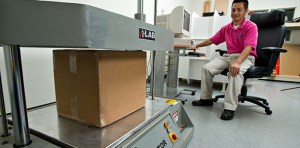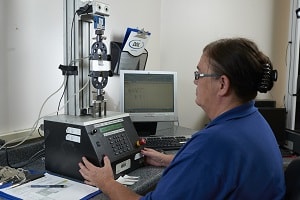At DDL, we do a lot of testing. We see many successful medical device package validations, but we do sometimes encounter the dreaded “failure” in a client’s validation.
Ali Payton, DDL packaging engineer, sat down with Scott Levy, DDL senior packaging engineer, to wrap up a two part video series to discuss some of the most common mistakes DDL regularly encounters with its clients regarding sterile packaging that can lead to failures during a package validation.
We hope that you will be able to take some valuable information away from this session and apply it in your own organization.
Materials
Q: What are some considerations clients should take when selecting materials for their sterile barrier system?
A: Understanding the product’s weight and geometry is key to this selection. In most instances, pouches tend to be more convenient as suppliers can typically get medical device manufacturers access to pouches quickly whereas trays tend to require more steps due to the formation of the cavity and sealant. Thus, many engineers try to use a pouch for heavier products and hope for the best. If you have a multi-material product with a lot of sharp edges or points, or a product with a lot of mass, you will likely want to go with a tray in this case.
For most companies, it comes down to speed in terms of getting their product to market. Thus, the more understanding upfront of what type of package configuration will work best for a product will help prevent failures down the road.
Process Validation
Q: What are some common mistakes DDL sees during the Process Validation?
A: Building a good process validation for your package validation is like building a new house; you need a solid foundation in order to build from it.
Some common mistakes DDL sees in the process validation include issues with over sealing, under sealing and general lack of understanding the actual processing parameters or strength levels. Stepping through the process validation is critical to having a successful package validation because if a failure arises, the more questions that can be answered from your process validation will only help prevent rework loops.
Understanding what the low and high ends are of your processing window is key and critical. If you are sealing at nominal every day and you encounter over sealed or under sealed packages, then it is obvious the sealer is not staying within tolerance.
Another important aspect of process validation is inspecting the seals, particularly after it has gone through sterilization, to make sure the seals have not experienced any adverse effects in sterilization.
Shipping Configuration
Q: What are some common mistakes DDL sees with shipping configurations?
A: Shipping configuration is paramount to a successful packaging system, as quite a few issues can be solved by simply implementing a better package shipment orientation. For example, if you are dealing with a heavy product, ideally the packages should be bottom oriented.
A failure mechanism DDL sees quite a bit is due to abrasion. When sterile packaging is put into corrugated shippers without shelf cartons this can lead to this type of failure. As corrugated packaging is nothing more than sandpaper. If you have too many packages inside the shipper, the sterile packages will rub against the corrugate and potentially cause holes due to abrasion, or you may find failures from the packages too closely packed and rubbing against each other causing abrasion.
Lastly, the use of shelf-cartons in your shipping configuration is critical, as they offer the most protection and will give you the best chance of passing a shipping validation. The make-up of the product should dictate the type of packaging being used. For instance, placing a multi-port product in a pouch and placing five to ten of these pouches in a corrugated shipper without shelf boxes may potentially cause a number of issues. You also want to avoid folding, bending, or creasing Tyvek pouches.
Compression & Distribution Testing
Q: DDL receives many questions on “failing” transportation simulation, specifically regarding ASTM D4169 DC 13. When a packaging system is not meeting the calculated load – what does this mean?
A: One of the biggest failure aspects DDL sees with shipping validations is compression. Within ASTM D4169 DC 13, the standard height utilized for the compression calculation is 108” and based upon that height, there is quite a large compressive load that comes down onto the packaging system. Many of DDL’s clients are concerned when they do not meet that specific calculated load, however it is not truly a failure as the test itself is a conditioning test that is simply telling you how much compression that box can withstand. Many of DDL’s customers prefer to use 54” instead of 108” for the stack height because the overall compression force is less. It is acceptable to use 54” if the products are being sent in a “Less than Truckload” (LTL) environment, but this is not the case if the products are being sent “Full Truckload” (FTL) per how the standard is written.
Another common distribution failure is regarding concentrated impacts within Schedule J of ASTM D4169. Ideally, every medical device manufacturer should have a single wall box that is at least 44 “Edge Crush Test”(ECT) or 275-pound burst strength rate as those are the two “magical” numbers you can use to exclude Schedule J. If you are proactive and understand what Schedule J is truly meant for, you can use a box to meet the requirements to exclude the dart impacts. While this may cost a bit more money upfront, it’s going to save heartache and headache down the road. Particularly for sterile packages, you want to avoid putting any undue necessary stresses on the packaging system as much as possible.
Bubble Leak Testing
Q: When performing package integrity testing, the Bubble Leak Procedure is commonly used. What are perceived failures in Tyvek during this test?
A: The spreading of woven Tyvek fibers may result in what is perceived as a failure during a bubble leak test. When Tyvek is folded, bent, or creased, it often creates a path where the fibers open letting air out giving the perception of a failure. Usually when this happens, dye penetration testing needs to be utilized as a secondary means to evaluate the perceived failure. This article discusses the common perception of failures in Tyvek:
Accelerated Aging
Q: What common issues are DDL sees with the sterile barrier system when clients are executing shelf-life studies?
A: Before putting samples of a sterile package system into accelerated aging, it is critical to understand what specific materials are being used and if they can handle the temperatures and humidities being used during aging. The other common issue that leads to failures during aging is under or over sealing on the package.
Another consideration that should be evaluated closely has to do with products that are hydrolytic and use of humidity within the aging process. Per ASTM F1980, if a product is hydrolytic then the use of 45-55% RH should be targeted. If you have a product that is hydrolytic and you are using a multi-layer material with a water based tie-layer, then separating out product aging from package validation aging should be considered as the higher elevated RH may cause delaminating issues with this type of sterile barrier.
Real Time Aging
A: For real time aging, there are benefits or disadvantages to storing samples internally or with a third party lab. The biggest consideration for real time aging is making sure you are documenting things correctly and have full traceability. The typical engineer stays with a company on average five to seven years these days. Thus, if you are doing a real time aging of 5 or 10 years it is likely a different engineer will be involved when the samples are ready.
One advantage then of having an outside lab, such as DDL, manage real time aging is that we will manage everything for you, so you don’t have to worry about your location of samples or documentation going missing if there is a change internally with your personnel.
Years and years of real time aging data is valuable data, so losing that is a huge risk. Fortunately, ISO 11607 allows you to use accelerate aging data to bring your product to market, but without the real time data you’re running into a huge problem should you be audited by the FDA as they will be looking for the real time data.
How working with an outside testing lab can help
As we’ve discussed, there’s a lot of considerations to be made when choosing your sterile barrier package packaging for successful validation. Many of these considerations can seem daunting but DDL is here to help throughout the process, as ultimately, we want to see our clients succeed. There is nothing worse than having to call someone after there is a failure. The benefit of working with DDL is we are just a phone call away to answer questions and make sure our customers are not going to run into problems.
If you have a packaging system prototype, DDL is happy to help take an initial look at this and point out any potential pitfalls that we may see upfront with the product configuration, packaging materials (tray or pouch), shipping configuration, or where the instructions for use (IFU) are going to be placed in the shipping configuration. Everyone is busy, and there are many pieces engineers don’t always take into consideration before moving forward with a full packaging validation; having a second set of eyes look at it helps ensure things are going to run smoothly the first time.
Feasibility studies are a great way to understand your packaging system before moving forward with full validation. We recommend running feasibility studies without even worrying about the sterilization aspect just to see how well that specific package configuration is going to perform.
Protocol review from an outside lab, such as DDL, is beneficial to make sure your testing is in compliance with the standards. A protocol review also helps an outside lab walk through and better understand what a customer is trying to accomplish to reduce any ambiguity, as well as make sure the test flows better and satisfies things from a compliance aspect. In many cases, it is faster and easier for DDL to generate the test protocol for the customer. We also recommend having separate process validation, package validation and product validation protocols, as it is much cleaner and easier to separate out in case something should go wrong with one or the other.
Please contact us if you have any further questions or need help on an upcoming package testing validation.

